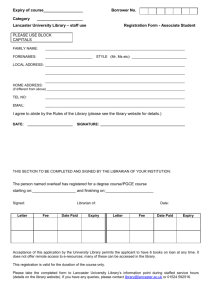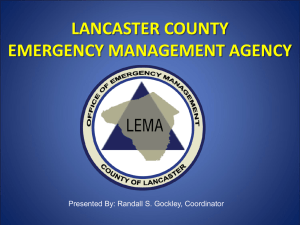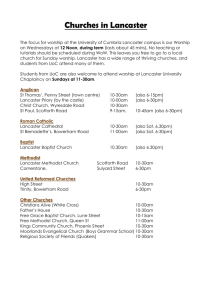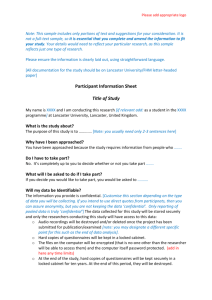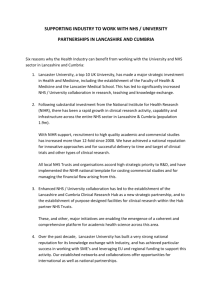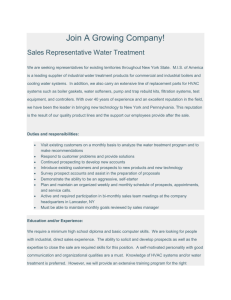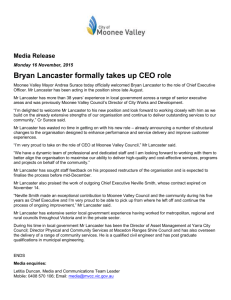A Seven Year Framework for the Arts in Lancaster District
advertisement
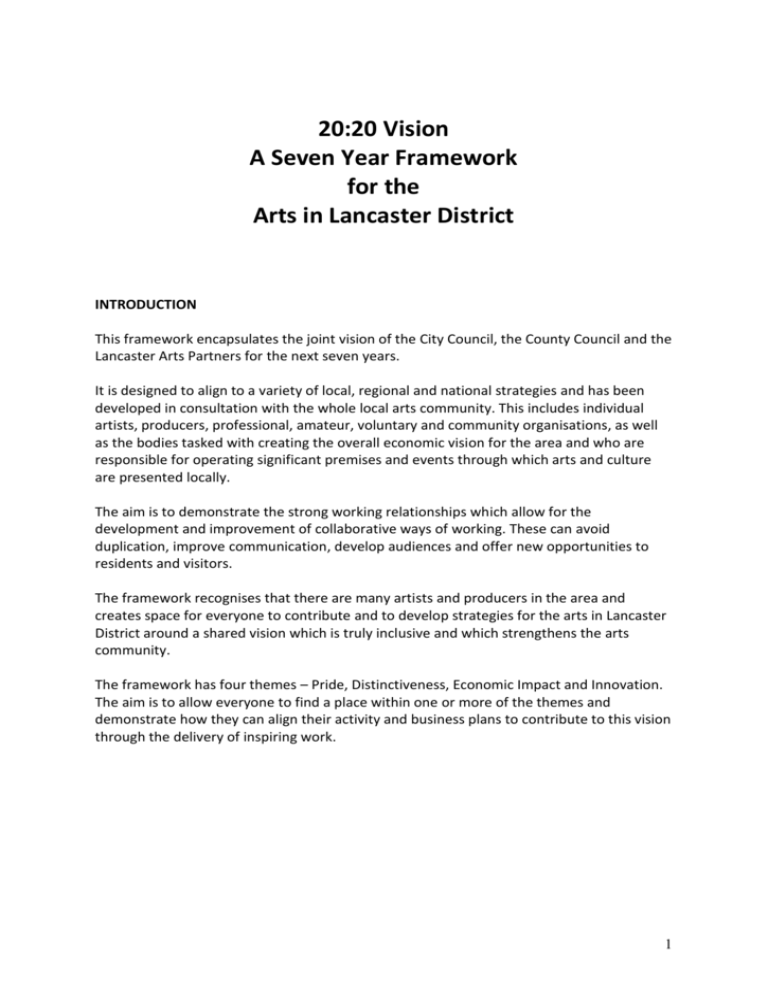
20:20 Vision A Seven Year Framework for the Arts in Lancaster District INTRODUCTION This framework encapsulates the joint vision of the City Council, the County Council and the Lancaster Arts Partners for the next seven years. It is designed to align to a variety of local, regional and national strategies and has been developed in consultation with the whole local arts community. This includes individual artists, producers, professional, amateur, voluntary and community organisations, as well as the bodies tasked with creating the overall economic vision for the area and who are responsible for operating significant premises and events through which arts and culture are presented locally. The aim is to demonstrate the strong working relationships which allow for the development and improvement of collaborative ways of working. These can avoid duplication, improve communication, develop audiences and offer new opportunities to residents and visitors. The framework recognises that there are many artists and producers in the area and creates space for everyone to contribute and to develop strategies for the arts in Lancaster District around a shared vision which is truly inclusive and which strengthens the arts community. The framework has four themes – Pride, Distinctiveness, Economic Impact and Innovation. The aim is to allow everyone to find a place within one or more of the themes and demonstrate how they can align their activity and business plans to contribute to this vision through the delivery of inspiring work. 1 20:20 VISION A Seven Year Framework for the Arts in Lancaster District By 2020, creativity and the arts will be a distinctive and outstanding component of the district’s cultural heritage offer and economy. We will have built on an established and enviable reputation across Lancashire and around Morecambe Bay for leadership and innovation in the delivery of high quality access to arts and cultural events. ASPIRATION To achieve international recognition for Lancaster as a district where culture and the arts are at the heart of civic life. The district will have an exceptional reputation for art, dance, theatre, music and literature. We want to see the City of Lancaster recognised as a beacon location for the arts where the concept of an “arts city” sits alongside a significant step change in the city’s offer as a destination for visitors, as a place to learn and as a top quality place to live and work. We want to see our coastal town of Morecambe, occupying the spectacular setting on Morecambe Bay, develop into an arts and festival town. We want to see young people staying in the district because of the unique and special features of the arts and cultural offer, whether they are born here or arrive as students. CONTEXT There is great potential for this vision to become reality: A unique city district combining historic city, dramatic coastline and stunning countryside An infrastructure of established arts organisations working together to drive development and supporting a cluster of established and new artists. A changing landscape with capital developments around the castle, the city centre and in other areas of the district A top 10 UK University, driving knowledge and innovation Close geographical links with the rest of Morecambe Bay and the Lake District including one of the UK’s newest Universities CONNECTIVITY The arts connect to the broadest range of priorities including health and well-being, environmental sustainability, urban and rural regeneration, the visitor economy, social care, education, learning and community cohesion. The current Lancaster Cultural Heritage Strategy highlights the key links between the arts, the retail offer and the heritage assets as part of the district’s overall visitor offer. In addition those very same assets play a key role in supporting the local economy, attracting students to our two universities, and maintaining Lancaster District as a location with high satisfaction levels as a place to live and work. The arts link to many local, sub regional, regional and national agendas. The outcomes outlined within the framework connect to Arts Council England Five Goals, Lancashire County Council’s Corporate Priorities and they contribute to the mainstream economic 2 development activities within the City Council’s Corporate Plan. Our vision is the driving force behind this framework and is supported by four key themes, each with its own set of outcomes. These are: PRIDE We want the arts to be a genuine source of local pride, at every level and across all of our communities, celebrating our district as a great place to live, work and visit. The 3 key outcomes are Improved regional, national and international recognition of our artistic output Increased participation in creative activity by children, young people and students Improved health and well being of our resident population and stronger themes of community cohesion DISTINCTIVENESS We want the arts to reflect local people’s culture, lives and ambitions. The 3 key outcomes are To embed local peoples culture, lives and ambitions within arts and cultural production Increased number of arts events and programmes that reflect the particular nature of the district and local people’s experiences and interests Increased opportunities for local artists, cultural organisations and venues to make work which illuminates the historic themes, built environment and open spaces and the unique sense of place of the district. ECONOMIC IMPACT We want the arts in Lancaster play a key role in the economic, social and cultural development of Lancashire and the wider region. The 3 key outcomes are Increased economic activity and new business development underpins the growth of the district The arts has a positive impact on the visitor economy The Universities attract growing numbers of high quality students INNOVATION We want the arts in Lancaster to innovate, challenge and surprise. The 3 key outcomes are Increased numbers of groundbreaking initiatives for young people and graduates Digital technologies become embedded within the arts and more people connect with Lancaster district’s digital arts and culture New cultural productivity is celebrated and emerging talent is supported 3 Proposed Signatories: We have invited the following organisations to work together to support the delivery of this vision. Sue Flowers Chair of LAP Eileen Blamire Leader of Lancaster City Council Marcus Johnstone - Cabinet Member for Environment, Planning an Cultural Services Lancashire County Council Professor Mark E Smith Vice Chancellor of Lancaster University Professor Peter Strike Vice Chancellor of University of Cumbria Alan Chesters Chair of Lancaster CVS Mrs Angela Seel President of the Chamber of Commerce Paul Cusimano Chair of the BID Management Team David Wood Principal of L&M College Chief Executive The Duchy of Lancaster Rob Cairns Sian Johnson John Wareing Jaqueline Greaves Kerry Kalokoh Lois Willis Chair of More Music Trustees Chair of the The Dukes Theatre Trustees Chair of Ludus DanceTrustees Chair of Litfest Trustees Chair of Green Close Steering Group Chair of Storey Gallery Trustees 4 MAKING A DIFFERENCE Within each of our four themes we will work together to deliver outcomes that focus on the changes which the framework wishes to bring about. Every artist and organisation can align its activity to these objectives and measure its achievements in relationship to the whole plan. We will start by prioritising three key developments which join up closely with the priorities for the long term planning and economic regeneration of the district . These are:LANCASTER ARTS CITY Enhancing structural change in Lancaster City centre. Adding quality through the arts to the positive changes in Lancaster centre alongside the reopening of Lancaster Castle as a heritage venue, public realm improvements through the City Council’s Square Routes project, and the development of the Canal Corridor North Area by British Land MORECAMBE FESTIVAL TOWN Enhancing the offer of Morecambe as an arts and festival town Building on decades of physical investment in regeneration by stimulating structural change in the local business offer to capture expenditure by visitors and residents alike in a potentially high value niche market at a focal point on Morecambe Bay YOUNG PEOPLE Enhancing the Student Experience and a niche offer for the diversity of the district’s young people. Retaining our home grown talent and encouraging graduate retention from those we train, by supporting and nurturing career development and work opportunities. Generating a range of new and exciting interactions with the arts, for, with and by young people 5 PRIDE Aim: By 2020 the arts will be a genuine source of local pride, at every level and across all of our communities, celebrating our district as a great place to live, work and visit. This will be achieved through the completion of three intended outcomes OUTCOME 1: Improved regional, national and international recognition of the artistic output We want to see our arts have a regional, national and international impact and reputation for excellence and for our historic city to be enhanced as a visitor destination, and a place to live and study by the arts. We will achieve this through the following activities: Hosting annual arts events that celebrate the city and that will become magnetic attractions for visitors and potential students Co-promotion of significant events within our arts and cultural offer with Marketing Lancashire, Visit England and LAP marketing team to national and international press and media Hosting internationally renowned artists in our arts, education and civic institutions Developing the Morecambe Festivals offer, bringing together the providers into a unified inspiring offer Delivering “Towards an Arts City: A Work in Progress”, a national conference on developing artistic excellence outside the large city context We will know we have achieved this when: We attract 100,000 people annually to Lancaster arts events We increase press coverage of Lancaster Arts in national press by 20% We have attracted at least 20 internationally renowned artists annually A Morecambe Festivals Partnership is established and an affordable annual programme of festivals is running. A national conference is held by 2020 OUTCOME 2: Increased participation in creative activity by all children, young people and students We want the arts to create a rewarding place for young people, for the district to be a place where students want to come to university and stay on to start their careers and where those who leave to study are inspired to return We will achieve this through the following activities: Working with arts providers to increase the number of projects and programmes focused on young people Working with schools, colleges and arts outreach providers and other organisations to ensure young people are aware of arts opportunities 6 Working with young people to establish what arts they want to do, when and where, and then supporting them to be involved in the delivery of arts events and activities Developing the Youth Arts Partnership as a forum for driving youth arts activity that promotes positive representations of young people Working with the student population to engage them with our arts programmes We will know we have achieved this when: We create 10 additional projects for children and young people each year Local arts organisations report a 50% increase of children and young people under 26 participating in projects Children and young people report a 25% increase in their creative skills We have at least one major youth arts festival and a sequence of smaller monthly events created by children and young people Sales of tickets and participation by students increases by 40% OUTCOME 3 Improved health and well being of our resident population and stronger themes of community cohesion We want Lancaster district to be an inspiring place to live and work in and to encourage participation in the arts for residents of all parts of the community We will achieve this through the following activities: Encouraging arts organisations to work in partnership with health, education, social services and local authority agencies Involving arts organisations in early planning around regeneration projects and programmes to ensure high-quality public spaces, public art and creative events are developed early in the life of the schemes Attracting new audiences and participants with high quality cultural experiences that are life changing Encouraging arts organisations to proactively embrace diversity Promoting environmental sustainability and making it a feature of creation of new work within the context of Morecambe Bay and the rural communities We will know we have achieved this when: Investment in the arts by health, education, social services and local authority agencies increases annually by 5% Regeneration projects are influenced by local artists and enhance local identity through resultant physical changes to the environment Case studies and community safety reports from police and other agencies reveal an increase of engagement of individuals and specific communities All arts organisations implement a Single Equality Action Plan Documentation, recordings and film of pieces of work evidence change 7 DISTINCTIVENESS Aim: The arts reflect local people’s culture, lives and ambitions. This will be achieved through the completion of three intended outcomes OUTCOME 1 To embed local peoples culture, lives and ambitions within arts and cultural production We want the arts to celebrate the unique history and landscape of Lancaster and Morecambe Bay We will achieve this through the following activities: Excellent ‘home produced’ events that are made in or inspired by the locality Connecting the arts to a renewed image for the district that illuminates the historic castle and countryside and dramatic appeal of the natural attributes of Morecambe Bay Education programmes at all stages of development that link creative learning into the locality across curriculum topics The First Friday offer features locally inspired work Conferences and research studies about sense of place at both universities We will know we have achieved this when : Each major arts organisation is able to report increased output that is locally inspired All publicity from the arts, tourism and education sectors reflects the new branding for the district Schools, Colleges and Universities use the Lancaster District experience to promote their offer and encourage progression within the district Documentation, press reports and recordings evidence change National press coverage is achieved and international visitors increase OUTCOME 2 Increased number of arts events and programmes that reflect the particular nature of the district and local people’s experiences and interests We want to see innovative programmes of work which inspire participation and bring local audiences and visitors to the districts distinctive offer. We will achieve this through the following activities: Innovative arts projects that reach out to communities who traditionally do not attend A developing seasonal programme of work that attracts significant visitor numbers A programme of work in rural locations An integrated heritage, festivals and cultural events programme which includes a significant free outdoor offer We will know we have achieved this when : 8 Case studies of arts participation work demonstrate increased engagement and reach Visitor figures significantly increase for the major seasonal events Reports from local village communities highlight the increase in arts and cultural provision from both major arts organisations and local artists A festivals and Events groups exists and brings in both significant investment and reports increased visitor numbers OUTCOME 3 Increased opportunities for local artists, cultural organisations and venues to make work which illuminates the historic themes, built environment, open spaces and the unique sense of place of the district. We want to see enlivened public spaces, artists developing careers and a sustainable arts infrastructure. We will achieve this through the following activities: Artistic improvements to areas of public realm – both temporary and permanent Arts and culture featuring prominently in the development of the Castle district and the Canal Corridor Commissions for cultural production which are inspired by the area Artistic consultations on urban design We will know we have achieved this when : Significant investment is made in public arts projects Existing arts buildings are improved with capital development funding and the new developments enhance the cultural offer 60 new commissions are created annually The Lancaster Design Awards are re-instigated 9 ECONOMIC IMPACT Aim: The arts in Lancaster District play a key role in the economic, social and cultural development of Lancashire and the wider region. This will be achieved through the completion of three intended outcomes OUTCOME 1 Increased economic activity and new business development underpins the growth of the district We want to see a thriving local economy fostering innovation and graduate retention We will achieve this through the following activities: The development of a flourishing creative industries sector that draws on the skills of the local arts scene New investment for start up businesses encouraged by the enhanced reputation of the district for creativity and innovation Staging more ambitious events Continued inward investment in the arts and cultural offer from ACE, local authorities and other funding bodies We will know we have achieved this when : Reports and information from the Chamber of Commerce and the LCC Economic Development acknowledge the value and economic impact of arts activities and outputs Year on year assessment by Chamber of Commerce and the LCC Economic Development show annual growth Documentation and evaluation reports show the economic benefits of specific events A new Economic Impact Assessment of the arts is undertaken in 2016 OUTCOME 2 The arts has a positive impact on the visitor economy We want to see people coming to stay for short and long breaks, benefiting retail, food, drink and leisure businesses We will achieve this through the following activities: Projects developed with BID to help regenerate the city centre with arts activity Cultural activity associated with the castle development is linked to city centre plans The district becomes a culturally vibrant place and hosts national and international events and conferences Developed Festival offer in Morecambe alongside retail and leisure business improvement We will know we have achieved this when : BID manager reports an increase in consumer spending and footfall attributed to new arts activity 10 Increased footfall from castle programme is reported by Duchy and the VIC Reports from press, media and event producers highlight the new programme Visitor numbers and feedback for the Morecambe Festival offer is positive OUTCOME 3 The Universities attract growing numbers of high quality students We want to see local arts and cultural offer being a major attraction for UK and international students coming to Lancaster We will achieve this through the following activities: New opportunities created to engage with academic teaching and research in the arts, design and across academic subjects The vibrant cultural offer attracts students, staff and visitors to the district Connected graduate support between the two universities and the whole cultural sector We will know we have achieved this when : University prospectuses show the value of the local arts product as an asset in attracting students LU Survey of student and staff satisfaction cite the district cultural offer as a significant feature There are increased numbers of placements and training opportunities in the arts through links with local education providers 11 INNOVATION Aim: The arts in Lancaster District will innovate, challenge and surprise. This will be achieved through the completion of three intended outcomes OUTCOME 1 Increased numbers of groundbreaking initiatives for young people and graduates We want to see future generations take a leading role in the creative development of the district We will achieve this through the following activities: Excellent youth leadership programmes linked to arts organisations and the voluntary sector Graduate placements, internships and creative apprenticeships linking the HE sector with the arts and cultural community Targeted fundraising within the sector Developing start up businesses linked to the commercial sector We will know we have achieved this when : 10 programmes of work are originated, created and produced by young people every year Every significant arts organisation is linked to a graduate placement opportunity £40,000 is raised annually for new work Chamber of Commerce and LCC Economic Development evidence new growth OUTCOME 2 Digital technologies become embedded within the arts and more people connect with the district’s digital arts and culture We want to see the reputation of Lancaster District to be synonymous with cutting edge developments in new media and see increased numbers of audiences and participants locally, regionally and internationally We will achieve this through the following activities: Development of a peer mentoring scheme that enables organisations to engage in knowledge and skills exchange Collaborative projects that connect new technologies with sense of place and bring visitors to the district Increased investment by the HE sector, the tourism sector and the arts community that enables artists to learn, study and develop new ideas New commissions with a digital dimension Increased number of arts programmes that support creative experimentation The developing festival and events programme engages with digital audiences We will know we have achieved this when : Reports and documentation of the schemes demonstrate the learning 12 4 new annual Creative industry sector partnerships are created with the arts and cultural community Audited accounts highlight the changes in funding 20 new works with a digital dimension are commissioned per year Discussions and reports at the annual gathering of the sector demonstrate the innovative new work Festival producers share reports that show the new developments OUTCOME 3 New cultural productivity is celebrated and emerging talent is supported We want to see the arts community refreshed and inspired We will achieve this through the following activities: Major collaborations across the arts community Mentoring schemes for new and emerging talent Artists and Arts organisations both support each other and act as critical friends We will know we have achieved this when : ACE and regional peers recognise the power of the new projects in funding support and critical reviews Annual Reports show an increase by 10% in young artist support, mentoring and volunteer schemes The quality of artistic product develops and this is demonstrated by independent assessment 13 WHO MAKES IT HAPPEN ? This section defines the Arts, Third Sector and Education communities who all contribute to this framework and benefit from its development. We hope everyone can find a place to contribute to the framework and recognise that this whole community will develop and change over the lifetime of this document. The local authority district of Lancaster – with its population centres in the historic city of Lancaster, the seaside resort of Morecambe, Carnforth and Heysham and the many smaller villages clustered around and in the rural areas of the lower Lune Valley has a long-standing tradition and extraordinarily high level of arts activity. Our district has the highest arts engagement levels in Lancashire and ranks number 6 out of the North West ‘s 44 districts - higher than most districts in our region’s cultural centres of Manchester and Liverpool. Our arts venues draw from over an hour away and include 3 theatres, 53 music venues, including pubs with regular live music offers, 20 art galleries, 10 venues for visiting and open mike comedy acts and 3 cinemas. Some 500 16-18 year olds living in our district are signed up on arts courses at 3 local colleges and our two universities attract students from across the UK and overseas to their arts courses. There are over 600 organisations, companies and individuals whose work involves arts associated activities. This cluster has created an attractive landscape for start-ups and inward investors in the creative industry sector. A leading role in the development of the cultural infrastructure has been taken by the Lancaster Arts Partnership (LAP), a consortium of arts organisations which exists to Offer a strategic vision for the arts in the Lancaster district Increase the profile and importance of arts in the district of Lancaster, regionally, nationally and internationally Initiate partnership, cross-art and cross-sectoral work that creates new opportunities LAP is Green Close, Litfest, Live at LICA, Ludus Dance, More Music, Storey Gallery and The Dukes Across the district there are a host of other commercial, amateur and independent arts organisations and providers ranging from commercial dance schools, galleries and visual arts groups to amateur performing arts companies and festival based organisations. Please see appendix for full list The education sector includes 8 children’s centres, 65 Primary schools, 8 SEN schools, 9 secondary schools, an FE college and 3 HE institutions. The 3rd sector includes an integrated network of voluntary and non-profit making organisations. 14 STRATEGIC INVESTMENT The arts in the District has grown and continues to develop a wider reach through the support of a number of significant investors. They come from a wide range of sectors demonstrating the added value that the arts in the district makes and the potential for the arts to be at the forefront of economic and social regeneration. This is not only investment in artistic practice and creative development but also in research and innovation, education and learning, employment opportunities and training, and in new ways of tackling social and welfare issues. In addition there is a developing investment from private individuals and corporations who are interested in sponsoring work and being identified with the cultural offer. This includes the retail and catering trade who are involved both as promoters of events but as contributors to the cost of events and programmes of work. We understand that the outcomes and targets in the framework will change in line with the strategic investment landscape. Arts Council England is the lead body charged with developing the arts in England. We champion, develop and invest in artistic and cultural experiences that enrich people’s lives. We support a range of activities across the arts, museums and libraries – from theatre to digital art, reading to dance, music to literature, and crafts to collections. Between 2011 and 2015, we will invest £1.4 billion of public money from government and an estimated £1 billion from the National Lottery to help create these experiences for as many people as possible across the country. www.artscouncil.org.uk . In 2010 we produced a strategic framework, Achieving great art for everyone, to focus our work over the next 10 years and encourage shared purpose and partnerships across the arts. It will help create the conditions in which great art can be made, experienced and appreciated by as many people as possible. It will support us in realising our vision of England as a world-leading creative and cultural nation. It will enable us to focus our investment and achieve even more impact. Arts Council England Ten-Year Strategic Framework champions ‘great art for everyone’ through five core aims: Goal 1: Talent and artistic excellence are thriving and celebrated Goal 2: More people experience and are inspired by the arts Goal 3: The arts are sustainable, resilient and innovative Goal 4: The arts leadership and workforce are diverse and highly skilled Goal 5: Every child and young person has the opportunity to experience the richness of the arts Lancaster City Council The City Council works with arts partners throughout the district to offer support and guidance where necessary. The council offers financial support by way of service level agreements with particular organisations and more generally via an arts development fund; both of which help deliver against council core priorities including health and wellbeing, economic regeneration and community safety. The council recognises the role a thriving arts sector has in creating and maintaining a sense of pride in the district and beyond. 15 Lancaster City Council’s Corporate Plan (with its four priorities) emphasises the role of the arts and culture in: Supporting the health and wellbeing of residents through increasing take-up of culture and leisure services Contributing to the economic growth of the district through increasing the number of people participating in arts, culture and entertainment events in the district, attracting increased numbers of visitors to the district and the development of a skilled creative workforce Creating clean, green and safe places for residents and visitors through a more attractive public realm, enhanced play and leisure spaces, and a number of diversionary activities for young people. Developing community leadership, through more effective joint working, increased engagement with residents and learning and skills development opportunities. The Council’s recently developed Cultural Heritage Strategy (2011) also demonstrates the commitment from The Council to preserving the district’s cultural assets and this arts framework sits alongside the frameworks for the development of Tourism, Retail and Food and Drink. Lancashire County Council LCC supports the arts in Lancaster through advice, advocacy and investment. Lancashire County Council's Cultural Drivers fund supports great art which transforms lives and places. The recent report Towards a Stronger Sense of Place (Pan-Lancashire Arts, Culture and Entertainment) offers key recommendations around the vision, investment and support for the arts in Lancashire to strengthen the sector. LCC Corporate Plan includes the following key objectives grouped into four themes. Our citizens • Growing up prepared for the future • Improving health and wellbeing • Supporting people in need Our communities • Making Lancashire communities safer • Making Lancashire communities stronger Our county • Promoting sustainable economic growth • Improving roads and transport • Protecting and improving our environment Our organisation Responding to significant financial, policy and service challenges means adapting our organisation to ensure it is fit for purpose while striving to ensure our customers receive the highest standards of service. This objective will shape the organisation in the future. Lancaster University 16 The University has supported and funded a range of campus-based public arts organisations since its founding nearly 50 years ago. These currently include the Ruskin Library, and the recently merged Nuffield Theatre, Peter Scott Gallery and Lancaster International Concerts, that together form Live at LICA. The recent strategy for 2020 states that “We will become a university that is globally significant - a leader in Higher Education that provides the highest quality research and teaching, and engages locally and internationally on the issues and debates of the day and the future. Driven by research and stimulating learning, the globally significant university informs and changes practice and thinking worldwide.” The 3 key priorities are 1. To produce world class research that changes practice and thinking 2. To transform people lives and society through teaching and student experience 3. To engage actively with students, businesses and our communities 17 IMPACT ASSESSMENT In order to make the case for the work that we all do and to show the genuine impact on the district, it’s residents, visitors and the economy we will gather quantitative and qualitative evidence through the following methods. In Year One we will set a baseline. TAKING THE TEMPERATURE – An annual gathering of the Arts Community This will focus on each of the themes and outcomes and assess progress linked to specific indicators. It will also open up new potential partnership projects and provide inspiration for everyone. ORGANISATIONAL MONITORING and EVALUATION Individual organisations and artists will monitor the impact of their own ongoing programmes and use existing methods were appropriate (eg ACE annual assessment reports) ECONOMIC and VISITOR DATA LCC STEAM data will be gathered to measure visitor numbers and Chamber of Commerce and BID reports will show changes in economic activity ECONOMIC IMPACT STUDY LAP will complete a second report in 2016, five years on, using the same tools and assumptions, to estimate the economic impact of the arts in the intervening period. TAKING PART SURVEY The annual DCMS survey for the district will give us data on levels of participation and engagement in culture and sport. We will use the previous Taking Part surveys to track any changes in participation levels and any hotspots and coldspots of engagement. PRESS and MEDIA LCC and all arts organisations will maintain press and media files that measure annual local, regional and national profile EDUCATION SURVEYS We will advocate with the ACEBO for a bi annual school survey that will measure creative engagement in a similar way to the current ‘State of the Region’ report. We will use the existing LU and University of Cumbria Student Satisfaction surveys. THIRD SECTOR and STATUTORY BODY REPORTS LCC will analyse and report on changes related to community safety, health and the environment gathered from local district annual reports. BEYOND OUR BORDERS We will also look at building strong links with the University of Lancaster, the Institute for Cultural Capital in Liverpool, the Centre for Cultural Policy Research in Glasgow and New Economy in Manchester and work with their research departments and use their tools to measure the impact of culture on positive image, communities, sense of place, the economy and identity. 18 INSPIRATIONS We gather our inspiration from many people and places. The visions that people create within their communities are often transferable and can be used to help develop our own. This is an ongoing process as every year new ideas arise and grand and small projects make us think and reflect. Dundee Similar size town/city to Lancaster/Morecambe, with a university, and is similarly distant from nearest urban conurbation. Unusually culturally active, tourism website emphasises this http://www.dundee.com - Dundee Contemporary Arts – “world class centre for contemporary art and culture” - Dundee Rep Theatre – “world class performing arts organisation” - Public art - over 120 artworks throughout the city. - Duncan of Jordanstone College of Art & Design – “The creative hub at the heart of the University of Dundee”. Graduate Susan Philipsz won Turner Prize in 2010 - Victoria & Albert (V&A) Museum has advanced plans for the V&A at Dundee. Exeter Similar size town/city to Lancaster/Morecambe, with a university, on a river, close to the sea, and to countryside, and is similarly distant from nearest urban conurbation, Royal Albert Memorial Museum and Art Gallery (RAMM) Recently re-opened after £24m Development Project. Won Museum of the Year 2012. Northcott Theatre on university campus Phoenix – performing and visual art Spacex gallery - contemporary art Utrecht, Holland About twice size of Lancaster/Morecambe. Has a university. Has active cultural life, second in the Netherlands to Amsterdam. Several theatres, art galleries, music venues. Aims to become cultural capital of Europe in 2018. Organise cultural Sundays. BAK - venue for contemporary art production. In her opening of a conference last year the artistic director, Maria Hlavajova, said “Utrecht is an outstandingly hospitable and generous place which...embraces art as it is tightly intertwined with the production of knowledge, and supports art’s political imperative to imagine things differently from how they are.” Newcastle/Gateshead An area which over the last twenty-five years has placed the arts at the centre of its thinking and transformation; also a partnership between two distinct places with common interests but divided by a river, which may have lessons for the relationship between Lancaster and Morecambe Folkestone A seaside town which is home to The Creative Foundation, an arts regeneration charity with a remit to manage a major project to restore the area’s vitality by encouraging creative enterprise. 19 Chester Animating their heritage through the Mystery plays, Roam the Walls, the summer festivals programme. Liverpool The development of LARK The legacy of the year of Capital of Culture Cumbria and in particular South Lakes Local authority investment in Lakes Alive partnerships The power of MINTFEST and MOUNTAIN FESTIVAL to draw a national and international community The Festival Town of Ulverston drawing new business 20
